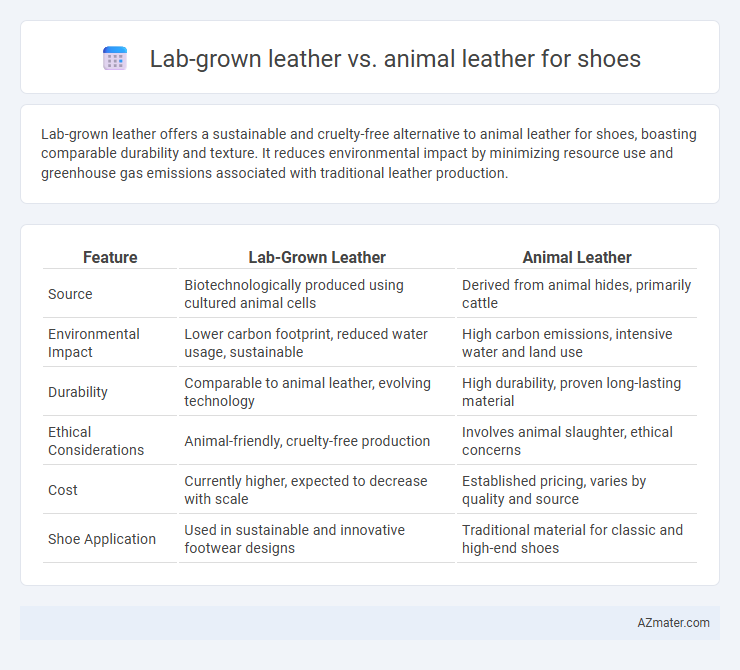Lab-grown leather offers a sustainable and cruelty-free alternative to animal leather for shoes, boasting comparable durability and texture. It reduces environmental impact by minimizing resource use and greenhouse gas emissions associated with traditional leather production.
Table of Comparison
| Feature | Lab-Grown Leather | Animal Leather |
|---|---|---|
| Source | Biotechnologically produced using cultured animal cells | Derived from animal hides, primarily cattle |
| Environmental Impact | Lower carbon footprint, reduced water usage, sustainable | High carbon emissions, intensive water and land use |
| Durability | Comparable to animal leather, evolving technology | High durability, proven long-lasting material |
| Ethical Considerations | Animal-friendly, cruelty-free production | Involves animal slaughter, ethical concerns |
| Cost | Currently higher, expected to decrease with scale | Established pricing, varies by quality and source |
| Shoe Application | Used in sustainable and innovative footwear designs | Traditional material for classic and high-end shoes |
Introduction to Lab-Grown and Animal Leather
Lab-grown leather, developed through biofabrication techniques using collagen-producing cells, offers a sustainable and cruelty-free alternative to traditional animal leather derived from cattle hides. Animal leather has been valued for its durability, breathability, and natural texture, making it a popular choice in shoe manufacturing for centuries. Advances in lab-grown leather aim to replicate these qualities while reducing environmental impact, water usage, and ethical concerns associated with livestock farming.
Production Processes Compared
Lab-grown leather is produced through biofabrication techniques involving cultured animal cells that grow collagen fibers in controlled environments, significantly reducing resource consumption and environmental impact compared to traditional leather tanning. Animal leather production relies on raising livestock, followed by intensive chemical tanning processes that emit pollutants and consume large amounts of water and energy. The precision and repeatability of lab-grown leather manufacturing allow for consistent material quality and scalability, contrasting with the variable qualities and ethical concerns tied to animal-derived leather.
Environmental Impact Analysis
Lab-grown leather for shoes significantly reduces environmental impact by minimizing land use, water consumption, and greenhouse gas emissions compared to traditional animal leather production, which is resource-intensive and contributes extensively to deforestation and methane emissions. The microbial fermentation processes used to create lab-grown leather produce less waste and avoid toxic chemicals often used in tanning animal hides, enhancing its sustainability profile. Lifecycle assessments reveal that lab-grown leather's carbon footprint can be decreased by up to 80%, making it a more eco-friendly choice for environmentally conscious footwear manufacturing.
Durability and Performance in Footwear
Lab-grown leather demonstrates comparable durability to traditional animal leather, offering resistance to wear and tear essential for high-performance footwear. Unlike animal leather, lab-grown variants provide consistent quality with fewer natural imperfections, ensuring uniformity in texture and strength. Advances in biofabrication also enhance breathability and moisture management, optimizing comfort and longevity in shoes.
Aesthetic Qualities and Customization
Lab-grown leather offers consistent texture and color, allowing for precise control over aesthetic qualities that can be difficult to achieve with traditional animal leather due to natural variations. Customization options are more extensive with lab-grown leather, including tailored colors, patterns, and finishes, enabling designers to create unique and innovative shoe designs. Animal leather, while prized for its natural grain and aging characteristics, presents limited customization capabilities and variability that may affect the uniformity of shoe aesthetics.
Cost and Market Accessibility
Lab-grown leather for shoes generally has higher production costs compared to traditional animal leather, primarily due to advanced biotechnological processes and limited large-scale manufacturing. Animal leather benefits from established supply chains, making it more accessible and affordable in global markets, particularly in developing regions. Market accessibility for lab-grown leather is expanding gradually with increasing investment and sustainability demand, but it remains a premium option compared to widely available animal leather.
Ethical Considerations and Animal Welfare
Lab-grown leather offers a significant ethical advantage over traditional animal leather by eliminating the need for animal farming and slaughter, addressing concerns about animal cruelty and exploitation. This sustainable alternative also reduces the environmental impact associated with livestock, aligning with growing consumer demand for cruelty-free and eco-friendly footwear. Choosing lab-grown leather supports animal welfare initiatives by promoting cruelty-free production methods without compromising the durability and aesthetic qualities desired in premium shoes.
Consumer Preferences and Trends
Consumer preferences increasingly favor lab-grown leather for shoes due to its sustainability, ethical production, and reduced environmental impact compared to traditional animal leather. Lab-grown leather offers customizable textures and durability, appealing to fashion-forward buyers seeking innovation without compromising quality. Market trends show a rising demand for cruelty-free and eco-friendly footwear options, driving brands to adopt lab-grown leather in response to conscious consumer values.
Scalability and Future Potential
Lab-grown leather offers significant scalability advantages over animal leather due to its controlled, laboratory-based production processes that can rapidly increase output without the limitations of livestock rearing. This innovative material reduces environmental impact by minimizing land use, water consumption, and greenhouse gas emissions, supporting sustainable mass production. The future potential of lab-grown leather includes customizable properties and integration with advanced manufacturing technologies, positioning it as a viable alternative for high-quality, scalable shoe production.
Conclusion: Which Leather is Best for Shoes?
Lab-grown leather offers a sustainable alternative to animal leather by reducing environmental impact and ethical concerns while maintaining durability and flexibility essential for high-quality shoes. Animal leather provides natural breathability, long-term wear resistance, and a classic aesthetic valued in premium footwear. The best choice depends on priorities such as sustainability, traditional feel, and longevity, with lab-grown leather excelling in eco-conscious innovation and animal leather remaining a benchmark for durability and craftsmanship.

Infographic: Lab-grown leather vs Animal leather for Shoe
 azmater.com
azmater.com